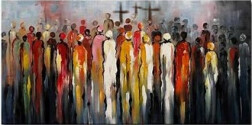“Faces at the Cross – Small Group Opportunity”
There were many faces in the crowd that witnessed the crucifixion of Jesus. Many of them are well known. Of course, there was Judas (who betrayed), Peter (who denied) and Pilate (who washed his hands). But there were many others as well. Lesser known, perhaps, and more likely to be “lost in the crowd.” As we journey through the season of Lent at Central, toward the cross of Good Friday and the empty tomb of Easter Sunday, we will look at some of these faces and be invited to see ourselves in each. And throughout, we will be reminded that through each of those faces – as through our own – the face of God shines.
Feb 18 Introduction – The Face of God
Feb 25 The Crowds (who exalted Jesus one day and cheered for his
Crucifixion the next)
Mar 4 Simon of Cyrene (who carried Jesus’ cross with him)
Mar 11 Roman Centurion (who confessed Jesus as he died)
Mar 18 Two Thieves (who were crucified alongside Jesus)
Mar 25 Many women (who stayed near Jesus as he died)

Each of the Faces at the Cross of Jesus’ crucifixion represents a story. A story so important, each was chosen to be part of the story of salvation as it was written through the life, death and resurrection of Jesus. During our Lenten sermon series, we will be exploring those stories in greater detail.
In that same spirit of storytelling, we are inviting you to be part of a Storytelling Small Group experience. Each week, three (3) small groups will be led by different leaders but all will be covering the same material. Participants will be a given a “storytelling prompt” ahead of time, based on the story we’ll be emphasizing in worship that week, and in the small group will share a story from their own life. We believe that stories are sacred, for God dwells in the stories that define us. And we believe there is transforming power in stories, both to unite us and change us. Moreover, we believe that there are more stories within us than we probably realize and the goal of this small group experience is to put us in touch with those stories.
Sunday, February 25 4:00 p.m.
All small group participants are asked to attend an opening orientation session
Tuesdays 1:00 p.m. Rm 240 Don Martin (2/27, 3/6, 3/13, 3/20, 3/27)
Tuesdays 4:00 p.m. Café Scott Woolridge (2/27, 3/6, 3/13, 3/20, 3/27)
Thursdays 5:30 p.m. Café Tina Miller (3/1, 3/8, 3/15, 3/22, 3/29)
At the opening orientation session, we will hand out the storytelling prompts for each week. But here’s a sample of what a prompt looks like:
Week 1 – Theme: the Crowds who welcomed Jesus on Palm Sunday and turned on him 5 days later
Minister’s Article Continued on Page 3….
Describe a time in your life when you “turned on a dime…”
Tell us about a time in your life when you “followed the crowd…”
Hope you can be part of this Lenten experience. Sign up in the Welcome Center for the small group of your choosing!!!
Blessings – Michael
